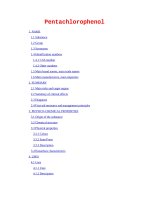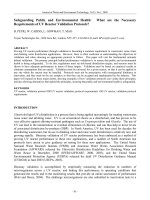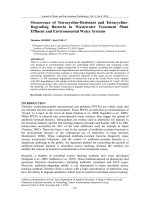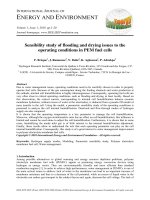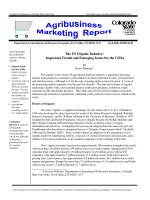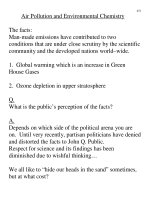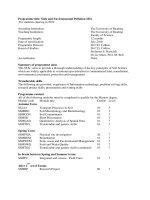Thermodynamics, solubility and environmental issues
Bạn đang xem bản rút gọn của tài liệu. Xem và tải ngay bản đầy đủ của tài liệu tại đây (7.27 MB, 463 trang )
Thermodynamics, Solubility and Environmental Issues
by Trevor M. Letcher (Editor)
•
ISBN: 0444527079
•
Publisher: Elsevier Science & Technology Books
•
Pub. Date: June 2007
Preface
Environmental problems are becoming an important aspect of our lives as
industries grow apace with populations throughout the world. Solubility is
one of the most basic and important of thermodynamic properties, and a property that underlies most environmental issues. This book is a collection of
twenty-five chapters of fundamental principles and recent research work,
coming from disparate disciplines but all related to solubility and environmental pollution. Links between these chapters, we believe, could lead to new ways
of solving new and also old environmental issues. Underlying this philosophy
is our inherent belief that a book is an important vehicle for the dissemination
of knowledge.
Our book "Thermodynamics, Solubility and Environmental Issues" had
its origins in committee meetings of the International Association of Chemical
Thermodynamics and in discussions with members of the International Union
of Pure and Applied Chemistry (IUPAC) subcommittee on Solubility, in particular Professor Glenn Hefter of the University of Monash, Perth, Dr Justin
Salminen of the University of California, Berkeley and Professor Heinz
Gamsj~ieger of the University of Leoben, Austria. It is a project produced under
the auspices of the IUPAC. In true IUPAC style, the authors, important names
in their respective fields, come from many countries around the world, including: Australia, Austria, Canada, Brazil, Finland, France, Greece, Italy, Japan,
Poland, Portugal, South Africa, Spain, United Kingdom and the United States
of America.
The book highlights environmental issues in areas such as mining,
polymer manufacture and applications, radioactive wastes, industries in
general, agro-chemicals, soil pollution and biology, together with the
basic theory and recent developments in the modelling of environmental
www.pdfgrip.com
Preface
pollutants - all of which are linked to the basic property of solubility. It
includes chapters on:
• Environmental remediation
• C O 2 in natural systems and in polymer synthesis
• Supercritical fluids in reducing pollution
• Corrosion problems
• Plasticizers and environmental pollution
• Surfactants
• Radioactive waste disposal problems
• Ionic liquids in separation processes
• Biodegradable polymers
• Pesticide contamination in humans and in the environment
• Pollution in a mining context
• Green chemistry
• Environmental pollution in soils
• Heavy metal and groundwater issues
• Biological uptake of aluminium
• Environmental problems related to gasoline and its additives
• Ionic liquids in the environment
• Body fluids and solubility
• B iosurfactants and the environment
• Problems related to polymer production
• Basic theory and modelling, linking thermodynamics and environmental pollution
I wish to record my special thanks to Professor Glenn Hefter, Professor
Heinz Gamsj/ieger and Dr Justin Salminen, who were part of the task team,
to the 49 authors and to Joan Anuels of Elsevier, our publishers. They have
all helped in producing, what we believe will be a useful and informative
book on the importance and applications of solubility and thermodynamics,
in understanding and in reducing chemical pollution in our environment.
Trevor M. Letcher
Stratton-on-the-Fosse, Somerset
2 September 2006
www.pdfgrip.com
vii
Foreword
Thermodynamics, Solubility and Environmental Issues - this book project was
started in 2005; it consists of 25 chapters which highlight the importance of
solubility and thermodynamic properties to environmental issues.
The opening chapter "An introduction to modelling of pollutants in the
environment" by Trevor M. Letcher demonstrates convincingly that equilibrium concepts and simple models lead to realistic predictions of, for example,
the concentration of a polychlorinated biphenyl in the fishes of the St. Lawrence
River. Relative solubilities expressed by octanol-water and air-water partition
coefficients play a crucial role for estimating the distribution of chemicals
in the environment. This is pointed out in the introductory chapter as well as
in others such as "Estimation of volatilization of organic chemicals from soil"
by Epaminondas Voutsas.
Solubility phenomena between solid and aqueous phases are treated in
the chapters "Leaching from cementitious materials used in radioactive waste
disposal sites" by Kosuke Yokozeki, "An evaluation of solubility limits on
maximum uranium concentrations in groundwater" by Teruki Iwatsuki and
Randolf C. Arthur, and "The solubility of hydroxyaluminosilicates and the
biological availability of aluminium" by Christopher Exley.
Supercritical fluids can be applied to remove polluting materials from
the environment. Theory and practice of this technology is of increasing interest at the present time. In "Supercritical fluids and reductions in environmental pollution" by Koji Yamanaka and Hitoshi Ohtaki focus their attention to
start with the thermodynamics and structure of supercritical fluids and then
describe the supercritical water oxidation process, the extraction of pollutant
from soils with supercritical carbon dioxide and other supercritical fluids,
and recycle of used plastic bottles with supercritical methanol. Andrew
I. Cooper et al. report on "Supercritical carbon dioxide as a green solvent for
www.pdfgrip.com
Foreword
polymer synthesis". Carbon dioxide is an attractive solvent alternative for the
synthesis of polymers; it is non-toxic, non-flammable, inexpensive, and readily
available in high purity. These authors have also developed methods for producing CO2-soluble hydrocarbon polymers or "CO2-philes" for solubilization,
emulsification, and related applications.
Prashant Reddy and Trevor M. Letcher outline the possibilities to use
ionic liquids for industrial separation processes in their chapter "Phase equilibrium studies on ionic liquid systems for industrial separation processes of
complex organic mixtures". Ionic liquids are a very promising class of solvents
which, after extensive research and development, will eventually be applied for
the separation of industrially relevant organic mixtures.
Regarding the chapters not yet mentioned suffice it to say that this book
altogether elucidates the interplay of solubility phenomena, thermodynamic
concepts, and environmental problems. I congratulate the editor and the
authors on this remarkable achievement in such a comparatively short time.
Heinz Gamsj~iger
Chairman of the IUPAC Analytical Chemistry Division (V),
Subcommittee on Solubility and Equilibrium Data
Professor Emeritus, Montanuniversitiiit, Leoben, Austria
www.pdfgrip.com
List of Contributors
Part I: Basic Theory and Modelling
1. An Introduction to Modelling of Pollutants in the Environment by Trevor M.
Letcher. Email:
Professor Trevor Letcher, School of Chemistry, University of KwaZuluNatal, Durban 4041, South Africa. Phone and Fax + 44-1761-232311.
2. Modeling the Solubility in Water of Environmentally Important Organic
Compounds by Ernesto Estrada, Eduardo J. Delgado and Yamil
Sim6n-Manso. Email:
Dr Ernesto Estrada, Edificio CACTUS, University of Santiago de Compostela,
15782 Santiago de Compostela, Spain. Phone + 34 981 563100, Fax 547077.
3. Modeling of Contaminant Leaching by Maria Diaz and Defne Apul.
Email:
Professor Defne Apul, Department of Civil Engineering, University of
Toledo, 2801 W Bancroft St, Mail Stop 307, Toledo, OH 43606, USA. Phone
+ 1-419-5308132.
Part II: Industry and Mining
4. Supercritical Fluids and Reductions in Environmental Pollution by Koji
Yamanaka and Hitoshi Ohtaki*. Email:
Dr Koji Yamanaka, Organo Co. of Japan, 1-4-9 Kawagishi Toda, Saitama
335-0015, Japan. Phone +81-48-446-1881, Fax +81-48-446-1966.
*Deceased
www.pdfgrip.com
List of Contributors
5. Phase Equilibrium Studies on Ionic Liquid @stems for Industrial
Separation Processes of Complex Organic Mixtures by Prashant Reddy and
Trevor M. Letcher. Email:
Professor Trevor Letcher, School of Chemistry, University of KwaZula-Natal,
Durban 4041, South Africa. Phone and Fax + 44-1761-232311.
6. Environmental and Solubility Issues Related to Novel Corrosion Control
by William J. van Ooij and R Puomi. Email: vanooijwj @email.uc.edu
Professor William van Ooij, Department of Chemical and Materials Engineering, 497 Rhodes Hall, University of Cincinnati, Cincinnati, OH 452210012, USA. Phone + 1 513 5563194, Fax + 1 513 5563773.
7. The Behavior of Iron and Aluminum in Acid Mine Drainage: Speciation,
Mineralogy, and Environmental Significance by Javier S. Espafia. Email:
Professor Javier S~inchez Espafia, Mineral Resources and Geology Division,
Geological Survey of Spain, Rios Rosas 23, 28003 Madrid, Spain. Phone
+ 34-913-495740, Fax + 34-913-495834.
Part III: Radioactive Wastes
8. An Evaluation of Solubility Limits on Maximum Uranium Concentrations in Groundwater by Teruki Iwatsuki and Randolf C. Arthur. Email:
iwatsuki.teruki @jaea.go.jp
Dr Teruki Iwatsuki, Mizunami Underground Research Laboratory, 1-64
Yamanouchi, Akeyo-Cho, Mizunami-Shi, Gifu 509-6132 JNC, Japan. Phone
+ 81 572 662244, Fax + 81 572 662245.
9. Leaching from Cementitious Materials Used in Radioactive Waste Disposal
Sites by Kosuke Yokozeki. Email: yokozeki @kajima.com
Dr Kosuke Yokozeki, Kajima Technical Research Institute, 19-1-2 Tobitakyu,
Chofu-shi, Tokyo 182-0036, Japan. Phone + 81-424-897816, Fax + 81-424897078.
Part IV: Air, Water, Soil and Remediation
10. Solubility of Carbon Dioxide in Natural Systems by Justin Salminen, Petri
Kobylin and Anne Ojala. Email:
www.pdfgrip.com
List of Contributors
xi
Dr Justin Salminen, Department of Chemical Engineering, University of
California, Berkeley, CA 94720-1462, USA. Phone 1(510) 642 1972, Fax
1(510) 642 4778.
11. Estimation of Volatilization of Organic Chemicals from Soil by
Epaminondas Voutsas. Email:
Professor Epaminondas C. Voutsas, School of Chemical Engineering,
National Technical University of Athens, 9 Heroon Polytechniou Street,
Zographou Campus, GR-15780 Athens, Greece. Phone +30 210-7723971,
Fax +30 210-7723155.
12. Solubility and the Phytoextraction of Arsenic from Soil by Two Different
Fern Species by Valquiria Campos. Email:
Dr Valquiria Campos, Polytechnic School, Chemical Engineering
Department, University of S~o Paulo, Rua Marie Nader Calfat, 351 apto 71
Evoluti, Morumbi, S~o Paulo, SP, Brazil 05713-520. Phone +55 30914663,
Fax +55 30313020.
13. Environmental Issues of Gasoline Additives -Aqueous Solubility and
Spills by John Bergendahl. Email:
Professor John Bergendahl, Department of Civil and Environmental
Engineering, Worcester Polytechnic Institute, Worcester, MA, USA. Phone
+ 1 508-8315772, Fax + 1 508-8315808.
14. Ecotoxicity of Ionic Liquids in an Aquatic Environment by
Daniela Pieraccini, Cinzia Chiappe, Luigi Intorre and Carlo Pretti. Email"
dpieraccini @tiscali.it
Dr Daniela Pieraccini, Dipartimento di Chimica Bioorganica e B iofarmacia,
University di Pisa, Via Bonanno 33, 56126 Pisa, Italy. Phone +39 0502219700, Fax + 39 050-2219660.
15. Rhamnolipid Biosurfactants: Solubility and Environmental Issues by
Catherine N. Mulligan. Email:
Professor Catherine Mulligan, Department of Building, Civil and Environmental Engineering, 1455 de Maisonneuve Boulevard West, Concordia
University, Montreal H3G 1M8, Canada.
16. Sorption, Lipophilicity and Partitioning Phenomena of Ionic Liquids in
Environmental Systems by Piotr Stepnowski. Email:
www.pdfgrip.com
List of Contributors
Professor Piotr Stepnowski, Faculty of Chemistry, University of Gdansk, ul.
Sobieskiego 18/19, PL80-952 Gdarisk, Poland. Phone +48 58 5235448,
Fax +48 58 5235577.
17. The Solubility of Hydroxyaluminosilicates and the Biological Availability
of Aluminium by Christopher Exley. Email:
Professor Christopher Exley, B irchall Centre for Inorganic Chemistry and
Materials Science, Lennard-Jones Labs, Keele University, Staffordshire ST5
5BG, UK. Phone +44 1782 584080, Fax +44 1782 712378.
18. Apatite Group Minerals: Solubility and Environmental Remediation by
M. Clara E Magalh~es and Peter A. Williams. Email:
Professor Clara Magalhaes, Departamento de Quimica, Universidade de
Aveiro, P-3810 Aveiro, Portugal. Phone +351 234-370200, Fax +351 234370084.
Part V: Polymer Related Issues
19. Solubility of Gases and Vapors in Polylactide Polymers by Rafael Auras.
Email:
Dr Rafael Auras, School of Packaging, Michigan State University, East
Lansing, MI 48824-1223, USA, Phone +1 517-4323254, Fax +1 5173538999.
20. Biodegradable Material Obtained from Renewable Resource: Plasticized
Sodium Caseinate Films by Jean-Luc Audic, Florence Fourcade and
Bernard Chaufer. Email:
Dr Jean-Luc Audic, Laboratoire Rennais de Chimie et d'Ingenierie, ENSCRUniversite Rennes 1, 35700 Rennes, France. Phone +33-223-235760,
Fax +33 223 235765.
21. Supercritical Carbon Dioxide as a Green Solvent for Polymer Synthesis
by Colin D. Wood, Bien Tan, Haifei Zhang and Andrew I. Cooper. Email:
aicooper@ liverpool.ac.uk
Professor Andrew I. Cooper, Donnan and Robert Robinson Laboratories,
Department of Chemistry, University of Liverpool, Liverpool L69 3BX, UK.
22. Solubility of Plasticizers, Polymers and Environmental Pollution by Ewa
Bialecka-Florjaficzyk and Zbigniew Florjaficzyk. Email:
www.pdfgrip.com
List of Contributors
Professor Zbigniew Florjaficzyk, Faculty of Chemistry, Warsaw University of
Technology, ul. Noakowskiego 3, PL-00 664 Warsaw, Poland. Phone +48 22
2347303, Fax +48 22 2347271.
Part VI: Pesticides and Pollution Exposure in Humans
23. Solubility Issues in Environmental Pollution by Alberto Acre and Ana
Soto. Email:
Professor Alberto Arce, Department of Chemical Engineering, University of
Santiago de Compostela, E-15782 Santiago de Compostela, Spain. Tel. +34
981 563100 ext 16790, Fax + 34 981 528050.
24. Hazard Identification and Human Exposure to Pesticides by Antonia
Garrido Frenich, F.J. Egea Gonz~ilez, A. Mar/n Juan and J.L. Martinez Vidal.
Email: agarrido @ual.es
Dr Antonia Garrido Frenich, Department of Hydrogeology and Analytical
Chemistry, University of Almeria, 04071 Almeria, Spain. Phone +34
950015985, Fax + 34 950015483.
25. Solubility and Body Fluids by Erich K6nigsberger and Lan-Chi
K6nigsberger. Email: koenigsb @murdoch.edu.au
Dr Erich K6nigsberger, School of Chemical and Mathematical Sciences,
Murdoch University, Murdoch, WA 6150, Australia.
www.pdfgrip.com
Table of Contents
Basic Theory and Modelling
CHAPTER 1: An introduction to modelling of pollutants in the environment (T.M.
Letcher).
CHAPTER 2: Modelling the solubility in water of environmentally important
organic compounds (E. Estrada et al.).
CHAPTER 3: Modeling of contaminant leaching (M. Diaz, D. Apul).
Industry and Mining
CHAPTER 4: Supercritical fluids and reductions in environmental pollution (K.
Yamanaka, H. Ohtaki).
CHAPTER 5: Phase equilibrium studies on ionic liquid systems for industrial
separation processes of complex organic mixtures (P. Reddy, T.M. Letcher).
www.pdfgrip.com
CHAPTER 6: Environmental and solubility issues related to novel corrosion control
(W.J. van Ooij, P. Puomi).
CHAPTER 7: The behaviour of iron and aluminum in acid mine drainage:
speciation, mineralogy, and environmental significance (J.S. España).
Radioactive Wastes
CHAPTER 8: An evaluation of solubility limits on maximum uranium
concentrations in groundwater (T. Iwatsuki, R.C. Arthur).
CHAPTER 9 : Leaching from cementitious materials used in radioactive waste
disposal sites (K. Yokozeki).
Air, Water, Soil and Remediation
CHAPTER 10: Solubility of carbon dioxide in natural systems (J. Salminen et al.).
CHAPTER 11: Estimation of the volatilization of organic chemicals from soil (E.
Voutsas).
www.pdfgrip.com
CHAPTER 12: Solubility and the phytoextraction of arsenic from soils by two
different fern species (V. Campos).
CHAPTER 13: Environmental issues of gasoline additives — aqueous solubility and
spills (J. Bergendahl).
CHAPTER 14: Ecotoxicity of ionic liquids in an aquatic environment
(D. Pieraccini etal.).
CHAPTER 15: Rhamnolipid biosurfactants: solubility and environmental issues
(C.N. Mulligan).
CHAPTER 16: Sorption, lipophilicity and partitioning phenomena of ionic liquids in
environmental systems (P. Stepnowski).
CHAPTER 17: The solubility of hydroxyaluminosilicates and the biological
availability of aluminium (C. Exley).
CHAPTER 18: Apatite group minerals: solubility and environmental remediation
(M.C.F. Magalhães, P.A. Williams).
www.pdfgrip.com
Polymer Related Issues
CHAPTER 19: Solubility of gases and vapors in polylactide polymers (R.A. Auras).
CHAPTER 20: Biodegradable material obtained from renewable resource :
plasticized sodium caseinate films (J-L. Audic et al.).
CHAPTER 21: Supercritical carbon dioxide as a green solvent for polymer synthesis
(C.D. Wood et al.).
CHAPTER 22: Solubility of plasticizers, polymers and environmental pollution (E.
Białecka—Florjańczyk, Z. Florjańczyk).
Pesticides and Pollution Exposure in Humans
CHAPTER 23: Solubility issues in environmental pollution (A. Arce, A. Soto).
CHAPTER 24: Hazard identification and human exposure to pesticides (A. Garrido
Frenich et al.).
CHAPTER 25: Solubility and body fluids (E. Königsberger, LC Königsberger).
www.pdfgrip.com
CH001.qxd
2/7/2007
2:45 PM
Page 3
Thermodynamics, Solubility and Environmental Issues
T.M. Letcher (editor)
© 2007 Elsevier B.V. All rights reserved.
Chapter 1
An Introduction to Modelling of Pollutants in the
Environment
Trevor M. Letcher
School of Chemistry, University of KwaZulu-Natal, Durban, 4041,
South Africa
1. INTRODUCTION
This chapter serves as an introduction to our book. We will consider where
a pollutant (for example, a fertilizer or herbicide), once introduced into the
environment, will end up. When any chemical is released into the air or water,
or sprayed on the ground, it will ultimately appear in all parts of the environment which includes the upper and lower atmosphere, lakes and oceans
and the soil, and in all animal and vegetable matter, including our bodies.
We will use simple models [1] for estimating the amount of a chemical distributed in various parts of the environment, commonly called environmental
compartments, and throughout the food chain. We will show the importance
of solubility data in these calculations and predictions. Furthermore, our
approach will be underpinned by basic thermodynamic principles.
Even at equilibrium, a chemical will be present in quite different concentrations in the different environmental compartments. For example, if a
volatile chemical is dissolved in water, its molar concentration in the air above
the water, at equilibrium, is generally quite different from its concentration
in the water [1, 2].
2. PARTITION COEFFICIENTS
The modelling of the partitioning of a chemical (pollutant) between water
and lipid material (body fat) is usually done through a knowledge of the
octanol–water partition coefficient, defined as:
ciO
K OW,i ϭ W
(1)
ci
www.pdfgrip.com
CH001.qxd
2/7/2007
2:45 PM
Page 4
4
T.M. Letcher
where ciO and ciW are the equilibrium concentrations of species i in the octanol
rich and the water layers, respectively, of a mixture of octanol and water
(partially miscible at 298.15 K), as depicted in Fig. 1.
n-Octanol, a simple compound, has been chosen as the chemical solvent
because it behaves in a similar way to lipid material (a complex material),
which includes the fat in our bodies and waxes in plants. In many cases it is
not the best model for lipids but it has now been widely accepted. There are
so much KOW data available in the literature that it is almost impossible to
change now. Correction factors are often applied to KOW when the properties
of a particular lipid material are known.
Hydrophobic compounds have large KOW values. The insecticide DDT
has a KOW value of ϳ106 and phenol, a hydrophilic compound, has a KOW of
29 at 298.15 K. Thus, under chemical equilibrium conditions, the concentration of DDT in lipid material will be 106 greater than it is in water. This lipid
material could indeed be the fat in fish.
Another partition coefficient that is useful in understanding the large
difference in concentration of a chemical species i in air (A) and water (W) is
the air–water partition coefficient, KAW:
ciA
K AW,i ϭ W
ci
(2)
The air–water partition coefficient is related to the Henry’s law constant for
sparingly soluble species. Let us consider a species i at equilibrium in a system of air and water. Equating partial pressures of i, pi, in the air and the water
i
ciO
octanol-rich phase
(79 mol % octanol and 21 mol % water)
ciW
water-rich (essentially pure water)
K OW,i = c iO/ciW
Fig. 1. n-Octanol–water partitioning at 298.15 K.
www.pdfgrip.com
CH001.qxd
2/7/2007
2:45 PM
Page 5
An Introduction to Modelling of Pollutants in the Environment
5
(or equating fugacities or chemical potentials) and using the ideal gas law
equation and Henry’s law (see Fig. 2):
piV ϭ ni RT
(3)
where ni is the amount (moles) of i in the air. Applying Raoult’s law at low
solute concentrations (Henry’s law) with one correction factor (the activity
coefficient, giϱ):
pi ϭ xiWgiϱ pivap
(4)
where xiW is the mole fraction of i in the water. Rearranging and equating we
obtain:
pi ϭ
ni
RT ϭ ciA RT
V
(5)
pi ϭ xiWgiϱ pivap ϭ xiW Hi ϭ ciW Hi′
(6)
where Hi and HiЈ are the Henry’s law constants related to mole fractions and
concentrations, respectively. Hence, KAW,i ϭ ciA/ciW ϭ HiЈ/RT.
At saturation or the solubility limit, ciW is the solubility in water, ciWS, and
ciA ϭ
pivap
RT
Hi
pi = xiγipivap
pivap
pi = xiHi
pi
Raoult’s law (γ = 1)
0
0
xi
Fig. 2. Ideal behaviour, Raoult’s law and Henry’s law.
www.pdfgrip.com
CH001.qxd
2/7/2007
2:45 PM
Page 6
6
T.M. Letcher
thus
pivap
K AW,i ϭ WS
ci RT
This only applies if the solubility is low, which is the case for many pollutants. By way of example [1, 2], the KAW for n-hexane is 74 and for DDT it
is ϳ1 ϫ 10Ϫ3. Thus, if a species i is in chemical equilibrium in different
phases there can be orders of magnitude difference in the concentration of i
in the different phases (see Fig. 3).
The Henry’s law constant, KAW, and the activity coefficient, g, can be
estimated for a specific chemical from its measured solubility in water. This
represents saturation conditions. At saturation, for a very sparingly soluble
compound, a pure chemical phase can exist in equilibrium with the saturated solution; thus, Eq. (4) becomes:
pi ϭ pivap ϭ xiWgiϱ pivap
(7)
and thus, xiWgiϱ ϭ 1.0 and xiWgiϱ ϭ 1/giϱ.
The mole fraction solubility is thus the reciprocal of the activity coefficient.
Substances that are sparingly soluble in water have large activity coefficients.
They also tend to have large Henry’s law constants and air–water partition
coefficients, because, as Eq. (6) shows:
Hi ϭ gi∞ pivap
The very low vapour pressure of DDT is largely offset by its large activity
coefficient. Solubility thus plays a key role in determining the partitioning
of chemicals from water to air, lipids and other phases such as soil and
sediments.
A
c DDT = 10−3
air
0
c DDT = 106
octanol/water
W
c DDT = 1
water
Fig. 3. The partitioning of DDT between water in octanol–water–air mixture based on
Eqs. (1 and 2).
www.pdfgrip.com
CH001.qxd
2/7/2007
2:45 PM
Page 7
An Introduction to Modelling of Pollutants in the Environment
7
3. MODEL ENVIRONMENTS
In order to predict the concentrations of a chemical species in the various
regions of a given environment, it is necessary to know the size of each region.
These regions or compartments can include the atmosphere (air), water
(rivers and lakes), soil (usually to a depth of ϳ15 cm), river and lake sediments, fish (aquatic biota) and plant material (terrestrial biota). In this chapter
we will focus on air, water, soil and aquatic biota. Other compartments such
as aerosols, concrete surfaces, etc., can also be considered. The size of each
depends on the particular circumstance. By way of example, the sizes of four
compartments, including a lake and fish, are given in Table 1 together with
relevant properties, needed for the modelling process [1, 2]. These values will
be used throughout this chapter.
4. EQUILIBRIUM PARTITION
The criterion for phase equilibrium of a chemical, i, between two phases is
equal chemical potential or fugacity, i.e.
mi′ ϭ mi′′ and
fi′ϭ fi′′
(8)
or in the case of ideal vapours:
pi′ ϭ pi′′
(9)
The equilibrium condition for a species i, partitioning between two liquid
phases, e.g. water (W) and chemical (c), is:
xiWgiW pivap ϭ xicgic pivap
(10)
Table 1
Properties of a model environment
Environmental region
Volume, V (m3)
Air
Water
Soil
Biota
1 ϫ 109
1 ϫ 106
15 ϫ 104
10
f
Density, d (kg mϪ3)
0.02
0.05
1.2
1000
1500
1000
Note: Here f is the mass fraction of organic material in the particular region, soil or biota.
www.pdfgrip.com
CH001.qxd
2/7/2007
2:45 PM
Page 8
8
T.M. Letcher
This would apply to the octanol–water phases and
xiWgiW pivap ϭ xi0gi0 pivap
(11)
For very hydrophobic species, xiW is very small, giW Ϸ giϱ, xi0 Ϸ 1 and gi0 Ϸ 1,
so xiW Ϸ 1/giϱ. As a result, the insecticide, DDT, has a giϱ value of ϳ106.
Substituting these values and assuming thermodynamic equilibrium, we see
that there can be a difference of many orders of magnitude between the concentration of a particular chemical species in one phase and the concentration
of the same species in another phase (see Fig. 3).
We can use these concepts to calculate the relative concentrations of a
chemical in equilibrium with air and water. For example, let us consider
1,1,1-trichloroethylene (T) – a common industrial pollutant in the environment defined in Table 1 [1, 2].
At 25ЊC, its vapour pressure, pTvap, is 12800 Pa and its solubility in
water, cTW, is 730 g mϪ3. Because it melts at Ϫ32ЊC we know that it is a liquid
at 25ЊC. Its molar mass (MW) is equal to 133.4 g molϪ1, so xT ϭ (cTW/MW)/
(106/18) ϭ 0.99 ϫ 10Ϫ4, where the molar volume of water is 18/106 mol mϪ3,
and hence, from Eq. (11), gTϱ Ϸ 10100, HTgTϱ pTvap ϭ 1.29 ϫ 108 Pa (mole
fraction)Ϫ1 and HTЈ ϭ (HT ϫ 18)/106 ϭ 2322 Pa m3 molϪ1; hence, KAW,T ϭ HTЈ/
RT ϭ 9.4 ϫ 10Ϫ1.
The concentration of trichloroethylene in air thus will be 0.94 times its
concentration in water, if equilibrium conditions are met.
The value of KOW for 1,1,1-trichloroethylene is 295. Using this value
we can quantify the concentration of the pollutant in the fish (biota) from a
knowledge of KBW for the pollutant, as the two terms are related by:
K BW,i
ciB
ϭ fB K OW,i
ciW
(12)
where fB is the mass fraction of lipid material (assumed to be equivalent in
solvent properties to octanol) in the biota and ciB the equilibrium concentration of i in the biota. Table 1 indicates that in fish, the fB value is 0.05. If the
concentration in water, ciW, for 1,1,1-trichloroethylene, is 1 ppm (1 mg LϪ1
or 1 gmϪ3), then ciB is ϳ15 ppm. Hence, we can say that a fish, swimming
in water contaminated with this particular trichloroethylene at a concentration
of 1 ppm, will be contaminated with the pollutant at a concentration of 15 ppm.
The group, fBKOW,i, is usually known as the bioconcentration factor.
Following on from Eq. (12) the more hydrophobic the polluting
species, the greater will be ciB. Let us consider the concentration of one type
www.pdfgrip.com
CH001.qxd
2/7/2007
2:45 PM
Page 9
9
An Introduction to Modelling of Pollutants in the Environment
of hydrophobic pollutant – a polychlorinated biphenyl (one of the infamous
PCBs), namely 2,2Ј,4,4Ј-tetrachlorobiphenyl in a river such as the St. Lawrence
River, and estimate its concentration in the fish in the river [1, 2]. An average
value given for PCBs in this river has been reported as 0.3 ppb (0.003 g mϪ3).
Let us assume that the only PCB in the river is 2,2Ј,4,4Ј-tetrachlorobiphenyl.
For this PCB, log KOW ϭ 5.90.
Hence,
ciB ϭ fB K OW,i ciW ϭ (0.05 ϫ 7.9 ϫ105 ϫ 0.3) ppb ϭ 11.9 ϫ103 ppb or gmϪ3 .
The predicted equilibrium concentration of PCB in fish is thus ϳ40000
times the concentration of the PCB in the water, an amazing magnification!
The experimental value of ciB for PCBs in the St. Lawrence River is
7 ϫ 103 ppb which is within an order of magnitude of our prediction based
on a very simple model.
A similar treatment can be made for soil contamination. Taking into
account that soil contamination (ciS) is measured in mg kgϪ1 and water is
usually mg LϪ1 we have for soil (S):
f K
(ciS )′ K SW
K SW
ϭ S OW
′ ϭ W ϭ
dS
dS
ci
(13)
where dS refers to the soil density.
We conclude that the substances of low solubility and high activity
coefficients in water will tend to bioconcentrate into fish and any other animal and reach concentrations that are many orders of magnitude higher than
the concentrations in water. These are usually referred to as hydrophobic or
“water hating”.
5. ENVIRONMENTAL DISTRIBUTION
With the above information we can describe the partitioning of a species
between the different regions of the environment as described in Table 1.
The total mass Mi of a pollutant is:
Mi ϭ mass i in air ϩ mass i in water
ϩ mass i in aquatic biota ϩ mass i in soil
Mi ϭ ciAVA ϩ ciWVW ϩ ciBVB ϩ ciSVS
ϭ KAW,iciWVA ϩ ciWVW ϩ KBW,iciWVB ϩKSW,iciWVS
www.pdfgrip.com
CH001.qxd
2/7/2007
2:45 PM
Page 10
10
T.M. Letcher
and hence
ciW ϭ
Mi
K AW,iVA ϩVW ϩ K BW,iVB ϩ K SW,iVS
(14)
Let us consider the distribution, in an environment defined in Table 1, of
1.00 kg of each of the three polluting chemicals: trichloroethylene (T), hexane
(H) and DDT (D). The necessary data are [1]:
Pollutant
KAW
log KOW
Trichloroethylene (T)
Hexane (H)
DDT (D)
0.048
74
1 ϫ 10Ϫ3
2.29
4.11
6.19
The density of air at 25ЊC and 1 atm is 1185 g mϪ3. Using the above
data, together with the data of Table 1 and Eq. (14), we calculate that cTW ϭ
0.020 mg mϪ3. This is well below the solubility in water of trichloroethylene,
which is 1100 g mϪ3.
cTA ϭ K AW cTW ϭ 0.96 ϫ10Ϫ3 mgmϪ3
Mass of T in air ϭ cTAVA ϭ 0.96 kg
cTS = K SW,T cTW = fS K OW,T cTW = 0.04 mgm −3
cTB = K BW,T cTW = fB K OW,T cTW = 0.195 mgm −3
The results given in Table 2 require careful analysis. Most of the trichloroethylene and the hexane are to be found in the air but the highest concentrations
are found in the biota, i.e. fish. For the DDT, however, most reside in the soil
but again, the highest concentrations are to be found in the fish. The calculations performed here suggest that the biota or the soil (which have the
highest chemical concentrations) would be the best to sample if one wished
to monitor chemicals in the environment.
We have shown that given only KOW and KAW (or the Henry’s law constant) for a pollutant, its concentration in various environmental regions can
be predicted. This model is a simple one and assumes that equilibrium takes
place at every compartment interface. It ignores flows in and out of the environment, the rate of diffusional processes and other time dependant effects.
In the next section we will consider these effects.
www.pdfgrip.com
CH001.qxd
2/7/2007
2:45 PM
Page 11
11
An Introduction to Modelling of Pollutants in the Environment
Table 2
Results of analysis
Region
Trichloroethylene
Air
Water
Soil
Biota
Hexane
Air
Water
Soil
Biota
DDT
Air
Water
Soil
Biota
Concentration (cT)
(mg mϪ3)
ppb (by mass) (T)
Percentage of
total (T)
0.96 ϫ 10Ϫ3
0.020
0.040
0.195
(cH)
1 ϫ 10Ϫ3
13.5 ϫ 10Ϫ6
1.74 ϫ 10Ϫ3
8.40 ϫ 10Ϫ3
(cD)
4.25 ϫ 10Ϫ6
4.25 ϫ 10Ϫ3
65
329
0.810
0.020
0.026
0.195
(H)
0.843
13.5 ϫ 10Ϫ6
1.16 ϫ 10Ϫ3
8.40 ϫ 10Ϫ3
(D)
3.586 ϫ 10Ϫ3
4.25 ϫ 10Ϫ3
43
329
97.0
3.0
0.0
0.0
(H)
100.0
0.001
0.003
0.000
(D)
0.005
0.005
99.8
0.003
Note: The concentrations, ciW, were calculated from Eq. (14).
6. ENVIRONMENTAL DISTRIBUTION USING A FLOW
MODEL [1]
This model takes into account both the flow of a chemical into and out of
the environmental region and the degradation, and formation of the chemical within the region. The model like the previous one assumes that there is
phase equilibrium between the environmental regions. The model is based
on the mass balance:
Rate of change of Rate at which Rate at which
i in the
ϭ i enters the Ϫ i leaves the
environment
environment
environment
d A
(ci VA ϩciWVW ϩciSVS ϩciBVB )
dt
dQ
dMi dQA A
dQ
dQ
ci,IN Ϫ A ciA ϩ W ciW,IN Ϫ W ciW
ϭ
ϭ
dt
dt
dt
dt
dt
A
W
B
S
Ϫ (kA ci VA Ϫ kW ci VW Ϫ kBci iVB Ϫ(kSc )i VS )
www.pdfgrip.com
(15)
CH001.qxd
2/7/2007
2:45 PM
Page 12
12
T.M. Letcher
The dQA/dt term is the air flow rate and the dQW/dt term the water flow
velocity. These terms would have units of m3 sϪ1. The k terms are degradation first order values (dc/dt ϭ –kc) [3] specific to each environment region.
The differential equation can be simplified as:
a
dciW
ϭ b Ϫ gciW
dt
(16)
where
aϭ K AW,iVA ϩVW ϩ K BW,iVB ϩ K SW,iVS
bϭ
dQ
dQA A
ci,IN ϩ W ciW,IN
dt
dt
(17)
(18)
and
dQ
dQ
g ϭ A ϩVA kA K AW,i ϩ W ϩVW kW ϩVB kB K BW,i
dt
dt
ϩVS kS K SW,i
(19)
The solution of the equation is:
ciW (t ) ϭ
b
Ϫgt
1Ϫ exp
a
g
(20)
One way of simplifying this equation is to assume a steady state condition
(t ϭ ϱ) which gives:
ciW (t ) =
b
g
(21)
Using the above theory, let us apply it to the real case of DDT pollution.
Although DDT has been out of production for almost two decades,
its concentration in water in a particular fresh water lake was found to be 1.00
mg mϪ3. That is 1 part per 109, i.e. 1 ppb. This is below its solubility in water
value which is 3.1 mg mϪ3. In this problem we will use the data below: (a) to
calculate the DDT concentrations in the air, biota and soil; (b) assuming that
the surrounding environment has the same DDT (no flow in or out), to calculate the time that will be required for the DDT concentration to fall by 50%.
www.pdfgrip.com
CH001.qxd
2/7/2007
2:45 PM
Page 13
An Introduction to Modelling of Pollutants in the Environment
13
For DDT, KAW ϭ 1 ϫ 10Ϫ3 and log KOW ϭ 6.19 (i.e. KOW ϭ 1.549 ϫ 106).
In our answer we will assume the model environment given in Table 1 and
the first order rate constant for DDT degradation:
by photolysis in water is 5.3 ϫ 10Ϫ7 hϪ1;
by hydrolysis in water is 3.6 ϫ 10Ϫ6 hϪ1;
by biodegradation in soil is 5.42 ϫ 10Ϫ6 hϪ1.
Assuming that the DDT has reached chemical equilibrium (after all, the time
scale is about two decades!) then as
cDA
K AW,D ϭ W
cD
then
cDA ϭ cDW K AW,D ϭ 1.00 ϫ1ϫ10Ϫ3 ϭ 1.00 ϫ10Ϫ3 mgmϪ3
and similarly,
cDS = cDW K SW,D = 1.00 × 0.01 × 1.549 × 106 = 15.49 × 103 mgm −3
cDB = cDW K BW,D = 1.00 × 0.05 × 1.549 × 106 = 77.4 × 103 mgm −3
Again, the highest concentrations of DDT are found in the fish and the soil
is also contaminated. Note that the DDT in the fish is 77000 times the concentration of the DDT in the water.
Of interest, the total mass of DDT in this environment (1 km ϫ
1 km ϫ 1 km) (see Table 1) is:
M ϭ cDWVW ϩ cDAVA ϩ cDSVS ϩ cDBVB
M (mgϪ1 ) ϭ (1.00 ϫ106 ) ϩ (1.00 ϫ10Ϫ3 ϫ109 ) ϩ (15.5 ϫ103 ϫ1.5 ϫ10 4 )
ϩ(77.4 ϫ103 ϫ10)
M ( kgϪ1 ) ϭ 1.00 ϩ1.00 ϩ 232 ϩ 0.8
M ϭ 234.8 kg
As we found before, most of the DDT resides in the soil – in this case it is
232 kg out of a total of 234.8 kg.
www.pdfgrip.com
